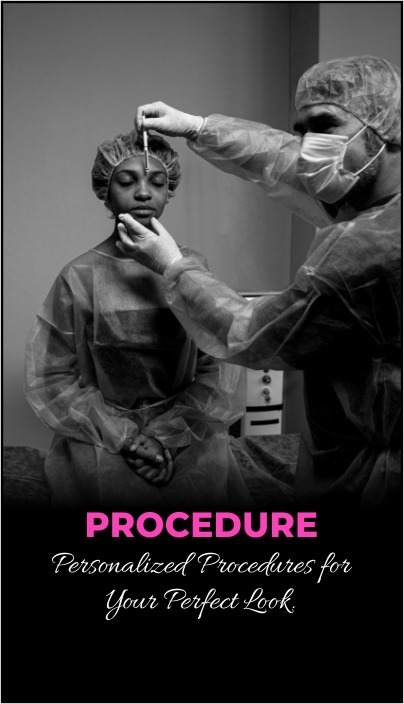

Earlobe tears are very common and often occur from continuously wearing heavy earrings. Traumatic events can also cause an earlobe defect, such as someone accidentally pulling out your earring in a pierced ear, a dog bite, or injury from a car accident. You might also have an enlarged hole in the lobe due to gauge piercings and want the lobe repaired to its original state.
Aging or natural irregularities may require an earlobe repair to restore the aesthetic appearance of your earlobe. Disfiguring keloid scars can form on the earlobe after piercing, causing itching and pain. Earlobe irregularities can draw unnecessary attention, affecting your self-esteem. Dr. Sivakumar offers a simple in-office procedure to repair earlobe defects and restore confidence.

Dermal filler injections have become a versatile solution in cosmetic dermatology, not only for facial enhancements but also for restoring the appearance of earlobes. Over time, earlobes can lose volume and elasticity, leading to sagging or elongation due to aging, frequent earring use, or genetics.
During the procedure, Dr. Sivakumar carefully injects dermal fillers, such as hyaluronic acid or collagen, into the earlobes to rejuvenate their appearance. This reduces sagging and wrinkling, giving a more youthful and firm look. The treatment is minimally invasive, with little to no downtime, and results can last several months to a year, depending on the filler type.
Dr. Sivakumar uses the excision technique to repair torn or elongated earlobes caused by trauma, heavy earrings, or aesthetic concerns. The technique involves removing damaged tissue and suturing the edges to restore the earlobe's natural shape. This procedure takes less than an hour and offers a permanent solution, customized to each patient’s needs, with minimal scarring.
Patients can expect not only functional restoration but also aesthetically pleasing results, boosting their confidence.
Dr. S. Sivakumar
MBBS, DLO, MS – General Surgery, MCh – Plastic Surgery, D.N.B (Plastic). Plastic & Cosmetic Surgeon with 26 years of experience overall (8 years as a specialist). Former Assistant Professor, Dept. of Plastic Surgery, CMCH, Coimbatore.
Dr. Sivakumar has extensive training in plastic and cosmetic surgery, with special interests in facial cosmetic surgery and procedures like facelifts, blepharoplasty, rhinoplasty, and more. He offers reconstructive surgery for facial deformities due to trauma, cancer, or congenital conditions. He is a member of prestigious associations, including the International Society of Aesthetic Plastic Surgery (ISAPS) and the Association of Plastic Surgeons of India (APSI).
The Covai Cosmetic Surgery provides meticulous earlobe repair for earlobes that are strained, ripped, or injured. Our board-certified dermatologists provide precise care for a range of issues, including split earlobes and strained piercings. Using cutting-edge methods, we recreate the earlobes’ original symmetry and form while offering customized treatments to boost self-esteem.
Our clinic provides individualized treatment for smooth, natural-looking outcomes, boosting both the look and functionality of the earlobes with accuracy and experience, whether restoring extended piercings or fixing damaged lobes. Consult the Best Dermatologist in Coimbatore Today at Covai Cosmetic Surgery.
Earlobe repair is a quick and simple procedure to correct split or torn earlobes, which usually result from wearing heavy earrings, wrong piercings, gauging, or other trauma to the earlobe. Ear lobe repair surgery should always be done in a clinical or hospital setup by a qualified Plastic Surgeon or Dermatologist.
Earlobe repair is a frequently performed cosmetic procedure that deals with a variety of problems affecting the earlobes, such as rips, strained piercings, or abnormalities brought on by trauma or aging. The surgical methods used in the procedure are designed to return the earlobes to their original integrity, uniformity, and form. Techniques including flap reconstruction, wedge excision, or simple closure may be used, depending on the particular issue. Non-surgical methods can also be used, such as injecting filler for damaged piercings.
Most of these adverse effects are temporary and resolve as the earlobe heals. Adhering to post-operative care recommendations can reduce discomfort and promote faster recovery.
The ideal candidate is someone in good overall health with realistic expectations. If you have a history of keloids or hypertrophic scarring, you may not be a good candidate. During the consultation, the surgeon will assess your condition and health to plan the surgery accordingly.
At Skinzest, earlobe repair surgery is performed by an expert plastic surgeon. Local anesthesia is administered to numb the area, and the procedure typically takes 20-30 minutes per earlobe. The surgeon removes excess tissue and uses fine stitches inside the earlobe to restore its shape.
Patients experience minimal discomfort during recovery. An antibiotic ointment is prescribed for application on the sutures. There is no downtime, and you can resume daily activities immediately. The surgery leaves a minute scar that is barely visible.
Yes, re-piercing is possible after a minimum of 4-6 weeks post-surgery.
Avoid wearing heavy earrings after the repair and develop a habit of removing earrings, even studs, before sleeping.
